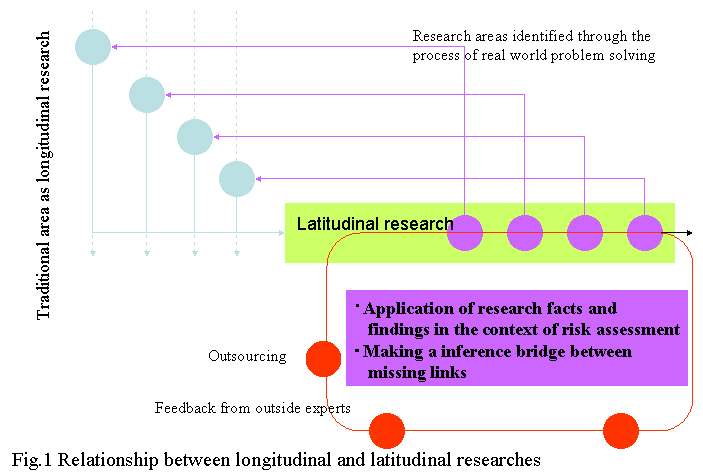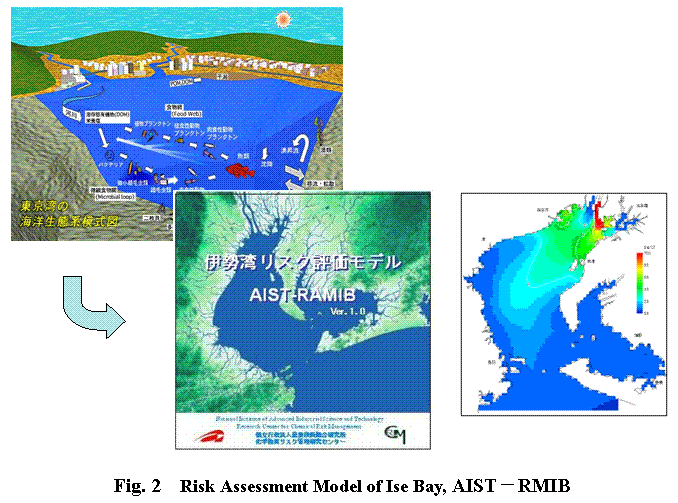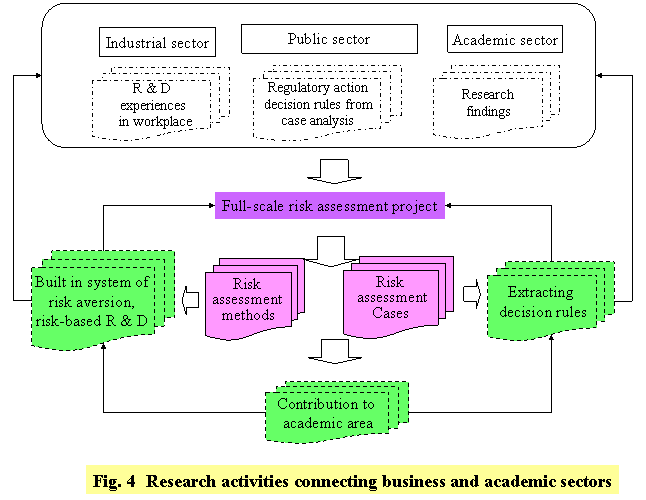Hydrosphere Environmental Assessment Team (HEAT) was newly established within CRM in April 2004, with five researchers, Kiyotaka Tsunemi, Ken-ichi Miyamoto, Mitsuo Iwata, Fumio Horiguchi and Akihiro Tokai (Team Leader), one post doctoral fellow, Joji Yamamoto and 4 members of technical staff, Mari Kotake, Mizuho Murai, Akemi Kawamoto, and Takako Suzuki).
(1) Mission of HEAT
The mission of HEAT is to contribute to chemical risk assessment and management through developing methodologies and performing case studies from the viewpoint of problem solving. In order to achieve our mission, HEAT has been engaged in development of methodologies including those that would realize the analysis of large scale fate and transport of chemicals in hydrosphere environment, and basin-wide ecological risk assessment. Also, HEAT has been working on the development and dissemination of hazard assessment system, risk management method based on system technology, and strategies in alternative selection with the example of flame retardants.
The highest priority of HEAT in 2004 is to carry forward the full-scale risk assessment of a specific chemical assigned to each researcher. In the process, each researcher in HEAT has vigorous discussions with other researchers in the related field as well as to incorporate comments from outside peer reviewers to enhance the contents of risk assessment. Fig.1 depicts the interactions of longitudinal and latitudinal researches aimed in the development of full-scale risk assessment. Through the process to develop risk assessment of a specific chemical, new research interests of HEAT are identified.

(2)Research outcomes
As one of the outcomes of the longitudinal research of HEAT, a software for exposure analysis, AIST-RAMTB (Risk Assessment Model of Tokyo Bay) was developed and released for public use. Fig. 2 shows the model configuration, and a typical exposure and risk outcome obtained in RAMTB. This software enables the users including those without the background scientific knowledge to perform ecological risk assessment given the endpoint of biota. The software is offered to the public free of charge. We will continue this open model strategy for other research areas.

(3) Research topics in FY2007
The research topics of HEAT in FY2007 are as follows:
■Risk assessment report with special interest of risk-risk trade-off
○ Additives
○ Industrial detergent
■Full-scale risk assessment
○ Flame retardants (Bromated, inorganic, phosphorus)
○ Nickel
■Development of an ecological risk assessment method with application of environmental epidemiology
■Development of a risk assessment model for coastal area.
■Development of a proposal on human health hazard assessment system based on comparative risk analyses
As one of the longitudinal research topics, HEAT is developing an ecological risk assessment method that realizes more realistic assessment of ecological risks. Application of the following new methods in ecological risk assessment is considered:
1) A method for extrapolation of population-level ecological risks among fish species with different life histories;
2) A method for application of environmental epidemiological analysis with basin-wide monitoring data.
Fig.4 depicts the overall structure of the research activities at HEAT and their implication within the social systems. From the sectors of industry, regulatory, and academia, various kinds of data, knowledge, and findings are obtained and applied in the context of risk assessment. The outcomes of the risk assessment developed by HEAT will be utilized as decision support tools and foundation for risk management. With active communications among stakeholders, HEAT is working towards establishing a good circulation of scientific knowledge between the society and academia, which revitalizes scientific research activities in academia.
